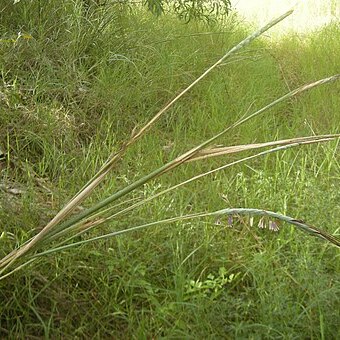Perennial from a tough rootstock. Culms stout, erect, hard, 1–3 m tall. Leaf sheaths keeled and flabellate at plant base, glabrous to hispidulous; leaf blades flat, stiff, 30–60 × 0.4–0.8 cm, glabrous to hirsute, apex acuminate; ligule very short, truncate, lacerate. Inflorescence a terminal raceme, sometimes with a few axillary racemes below it. Racemes 8–15 cm (excluding awns), 5–11-awned, 12–15 pairs of flat green homogamous spikelets below awned fertile pairs. Sessile spikelet 6–10 mm, dark brown at maturity; callus ca. 6 mm, pungent, densely brown bearded; lower glume linear-oblong, brown puberulous or pubescent, deeply grooved on either side of midvein; awn 9–16 cm, brown, column shortly pubescent. Pedicelled spikelet 15–20 mm, lower glume oblong-lanceolate, green, laterally asymmetrically winged, glabrous. Fl. and fr. Oct–Mar.
A large grass. It keeps growing from year to year. It grows 2-3 m high. It forms loose tussocks. The stems are 2-3 m tall. The leaves are 5-12 cm long by 0.3-0.4 cm wide. The flower spikes are 5-15 cm long. The male spikelets are 1-2 cm long and the female spikelets are 0.6-0.8 cm long.

